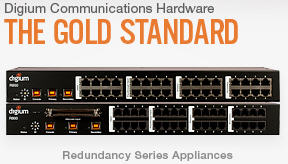Digium R-Series Redundancy vs. Xorcom and RedFone
The newly released Digium R-Series redundancy appliances enable your network to recover from hardware or software failures and maintain communication with the outside world.
Digium failover appliances work with their open source telephony platform Asterisk to ensure that you have an open line of communication even in demanding enviroments.
There are two models in the R-Series. They work on Asterisk based open sourced PBX’s but do not work on Switchvox. Both models are 1U rack mount devices:
- Digium R800: Supports up to eight analog (POTS) circuits.
- Digium R850: Handles up to eight digital (T1, E1, PRI or BRI) spans.
What’s The Difference?
So even in the event of a catastrophic failure, your communications system will stay up and running with the Digium R-Series. That sounds great but, what makes these appliances different from other redundant systems that work with Asterisk?
With the help of Digium engineer Pete Engler, here’s how the R-Series stacks up agains other popular appliances from Xorcom and RedFone.
Digium vs. Xorcom
The combination of Xorcom Astribank (HW Channel Bank) and Xorcom TwinStar (Software for redundancy) is a similar application to the Digium R-Series. Below are the main differences between using the R-Series and Xorcom for redundancy:
Cost
- The Astribank hardware can run a customer up to four times the cost of R-Series appliances depending on the number of T1 interfaces that are populated in the Astribank. All eight T1 ports are included in the R-Series for $995 list price.
- The Xorcom TwinStar software is an additional cost. The open source tools used for the servers connected to the R-Series is downloadable and is free to use.
Hardware Platform
- The Xorcom Astribank channel bank has more parts, such as a power supply, that are prone to fail. Digium utilizes USB power from the servers to power the R-Series which is much less vulnerable.
- R-Series is 1U rack mountable and therefore takes up less space in the rack than the 2U Astribank.
Functionality
- The TwinStar/Astribank solution can only detect a hardware power failure if the Linux kernel has crashed. It cannot detect if Asterisk has stopped working but is with the R-Series solution (along with loss of power detection).
- If the R-Series were to lose power, the PSTN spans will continue to function through the same ports at the time of power failure. The Astribank will cease to operate at this point and communication with the PSTN is down.
Digium vs. RedFone
The RedFone gateways are another application where redundancy can be introduced to a customer location. By nature, gateways operate in a completely different manner than the R-Series for providing redundancy.
- A gateway is converting the PSTN TDM circuits to an IP format. RedFone uses TDMoE. Digium R-Series offers physical layer switching and does not convert the signal at all from one network to another.
- If the RedFone loses power, communications cease in their gateway.
- To deploy a redundant system, multiple gateways would need to be installed and therefore will be more expensive than the R-Series. Providing redundancy for up to eight T1’s will be at least four times the cost, just like the Xorcom solution, including several additional hardware pieces to manage in the datacenter.
